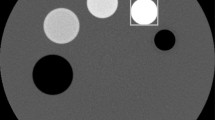Abstract
In X-ray computed tomography (CT), angular tube current modulation (TCM) minimizes the unnecessary travel of X-rays in the anteroposterior direction. This study aimed to evaluate the performance of near-real time angular TCM in a CT scanner using a real-time dosimeter when different-sized elliptical phantoms were scanned. Air kerma and air kerma rate profiles of small and large elliptical phantoms were measured using a solid-state detector with a fixed tube current (FTC) and TCM with the same volume CT dose index (6.20 mGy for the small phantom and 12.32 mGy for the large phantom) displayed on the CT console. Image noises were evaluated by measuring the standard deviation of CT numbers in specific regions in the phantoms. The air kerma at the central and upper and lower peripheral holes were decreased with TCM, whereas air kerma at left and right peripheral holes were increased. With both phantom sizes, the air kerma rate profiles stabilized when TCM was used after the first two cycles. The standard deviations of CT numbers in images of the small phantom were 10.7 ± 1.3 and 10.3 ± 1.2 Hounsfield units (HU) with the FTC and TCM, respectively, and those of the large phantom were 20.6 ± 2.0 and 19.6 ± 1.7 HU, respectively. Therefore, angular TCM can adjust the tube current during each tube rotation according to the phantom’s angular attenuation profile and can decrease the image noises. It can also decrease the variance of air kerma within the in-plane direction.






Similar content being viewed by others
References
Mettler FA Jr, Thomadsen BR, Bhargavan M, Gilley DB, Gray JE, Lipoti JA, et al. Medical radiation exposure in the U.S. in 2006: preliminary results. Health Phys. 2008;95:502–7.
Kalra MK, Maher MM, Toth TL, Schmidt B, Westerman BL, Morgan HT, et al. Techniques and applications of automatic tube current modulation for CT. Radiology. 2004;233:649–57.
Lee TY, Chhem RK. Impact of new technologies on dose reduction in CT. Eur J Radiol. 2010;76:28–35.
Haaga JR, Miraldi F, MacIntyre W, LiPuma JP, Bryan PJ, Wiesen E. The effect of mAs variation upon computed tomography image quality as evaluated by in vivo and in vitro studies. Radiology. 1981;138:449–54.
Kalender WA, Wolf H, Suess C. Dose reduction in CT by anatomically adapted tube current modulation: phantom measurements. Med Phys. 1999;26:2248–53.
McCollough CH, Bruesewitz MR, Kofler JM Jr. CT dose reduction and dose management tools: overview of available options. Radiographics. 2006;26:503–12.
Redžić M, Beganović A, Čiva L, Jašić R, Skopljak-Beganović A, Vegar-Zubović S. Quality control of angular tube current modulation. IFMBE Proc. 2017;62:563–7.
Greess H, Wolf H, Baum U, Lell M, Pirkl M, Kalender W, et al. Dose reduction in computed tomography by attenuation-based on-line modulation of tube current: evaluation of six anatomical regions. Eur Radiol. 2000;10:391–4.
Tack D, De Maertelaer V, Gevenois PA. Dose reduction in multidetector CT using attenuation-based online tube current modulation. AJR Am J Roentgenol. 2003;181:331–4.
Salehhon N, Hashim S, Karim MKA, Ang WC, Musa Y, Bahruddin NA. 128 slice computed tomography dose profile measurement using thermoluminescent dosimeter. J Phys Conf Ser. 2017;851:012002.
Söderberg M, Gunnarsson M. The effect of different adaptation strengths on image quality and radiation dose using Siemens care dose 4D. Radiat Prot Dosim. 2010;139:173–9.
Herrnsdorf L, Björk M, Cederquist B, Mattsson CG, Thungström G, Fröjdh C. Point dose profile measurements using solid-state detectors in characterization of computed tomography systems. Nucl Instrum Methods Phys Res Sect A. 2009;607:223–5.
Muramatsu Y, Ikeda S, Osawa K, Sekine R, Niwa N, Terada M, et al. Performance evaluation for CT-AEC (CT automatic exposure control) systems. Nihon Hoshasen Gijutsu Gakkai Zasshi. 2007;63:534–45.
Brisse HJ, Madec L, Gaboriaud G, Lemoine T, Savignoni A, Neuenschwander S, et al. Automatic exposure control in multichannel CT with tube current modulation to achieve a constant level of image noise: experimental assessment on pediatric phantoms. Med Phys. 2007;34:3018–33.
Söderberg M, Gunnarsson M. Automatic exposure control in compured tomography – an evaluation of systems from different manufacturers. Acta Radiol. 2010;51:625–34.
Raman SP, Mahesh M, Blasko RV, Fishman EK. CT scan parameters and radiation dose: practical advice for radiologists. J Am Coll Radiol. 2013;10:840–6.
Acknowledgments
This work was supported by JSPS KAKENHI Grant Number JP18K07746.
Author information
Authors and Affiliations
Corresponding author
Ethics declarations
Conflict of interest
The authors declare that they have no conflict of interest.
Ethical approval
This article does not contain any studies with human participants or animals performed by any of the authors.
Informed consent
Not applicable.
Additional information
Publisher’s note
Springer Nature remains neutral with regard to jurisdictional claims in published maps and institutional affiliations.
This article is part of the Topical Collection on A Sustainable Future for Medical Physics
Rights and permissions
About this article
Cite this article
Matsubara, K., Kawashima, H., Kobayashi, M. et al. Performance evaluation of near-real time angular tube current modulation in X-ray computed tomography using real-time dosimeter: a phantom study. Health Technol. 10, 1437–1443 (2020). https://doi.org/10.1007/s12553-020-00473-y
Received:
Accepted:
Published:
Issue Date:
DOI: https://doi.org/10.1007/s12553-020-00473-y




